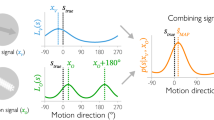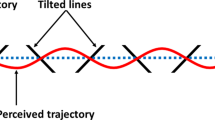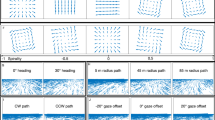Abstract
Dot patterns sliding transparently across one another are normally perceived as independently moving surfaces. Recordings from direction-selective neurons in area MT of the macaque suggested that this perceptual segregation did not depend on the presence of two peaks in the population activity. Rather, the visual system seemed to use overall shape of the population response to determine the number and directions of motion components. This approach explained a number of perceptual phenomena, including susceptibility of the motion system to direction metamers, motion patterns combining three or five directions incorrectly perceived by subjects as comprising only two directions. Our findings offer insights into the coding of multi-valued sensory signals and provide constraints for biologically based computational models.
This is a preview of subscription content, access via your institution
Access options
Subscribe to this journal
Receive 12 print issues and online access
$209.00 per year
only $17.42 per issue
Buy this article
- Purchase on Springer Link
- Instant access to full article PDF
Prices may be subject to local taxes which are calculated during checkout




Similar content being viewed by others
References
Graziano, M. S. A., Andersen, R. A. & Snowden, R. J. Tuning of MST neurons to spiral motions. J. Neurosci. 14, 54–67 ( 1994).
Albright, T. D. Direction and orientation selectivity of neurons in visual area MT of the macaque. J. Neurophysiol. 52, 1106– 1130 (1984).
Snowden, R. J., Treue, S. & Andersen, R. A. The response of neurons in areas V1 and MT of the alert rhesus monkey to moving random dot patterns. Exp. Brain Res. 88, 389–400 ( 1992).
Britten, K. H. & Newsome, W. T. Tuning bandwidth for near-threshold stimuli in area MT. J. Neurophysiol. 80, 762–770 (1998).
Williams, D. & Sekuler, R. Coherent global motion percepts from stochastic local motions. Vis. Res. 24, 55–62 (1984).
Pasternak, T., Albano, J. E. & Harvitt, D. M. The role of directionally selective neurons in the perception of global motion. J. Neurosci. 10, 3079–3086 (1990).
Jasinschi, R., Rosenfeld, A. & Sumi, K. Perceptual motion transparency: the role of geometrical information. J. Opt. Soc. Am. A Opt. Image Sci. Vis. 9, 1865–1879 (1992).
Mulligan, J. B. Motion transparency is restricted to two planes. Invest. Ophthalmol. Vis. Sci. Suppl. (1992).
Verstraten, F. A., Fredericksen, R. E. & Van de Grind, W. A. Movement aftereffect of bi-vectorial transparent motion. Vis. Res. 34, 349– 358 (1994).
Grunewald, A. & Lankheet, M. J. M. Orthogonal motion after-effect illusion predicted by a model of cortical motion processing. Nature 384, 358–360 ( 1996).
Wilson, H. R. & Kim, J. A model for motion coherence and transparency . Vis. Neurosci. 11, 1205– 1220 (1994).
van Wezel, R. J. A. et al. Responses of complex cells in area 17 of the cat to bi-vectorial transparent motion. Vis. Res. 36, 2805– 2813 (1996).
Recanzone, G. H., Wurtz, R. H. & Schwarz, U. Responses of MT and MST neurons to one and two moving objects in the receptive field. J. Neurophysiol. 78 , 2904–2915 (1997).
Mather, G. & Moulden, B. A simultaneous shift in apparent directions: Further evidence for a ‘distribution-shift’ model of direction coding. Q. J. Exp. Psychol. 32, 325–333 (1980).
Salzman, C. D. & Newsome, W. T. Neural mechanisms for forming a perceptual decision. Science 264 231–237(1994).
Williams, D., Tweten, S. & Sekuler, R. Using metamers to explore motion perception. Vis. Res. 31, 275–286 ( 1991).
Maunsell, J. H. R. & Van Essen, D. C. Functional properties of neurons in middle temporal visual area of the macaque monkey. II. Binocular interactions and sensitivity to binocular disparity. J. Neurophysiol. 49, 1148–1167 (1983).
Bradley, D. C., Qian, N. & Andersen, R. A. Integration of motion and stereopsis in middle temporal cortical area of macaques. Nature 373, 609 –611 (1995).
DeAngelis, G. C., Cumming, B. G. & Newsome, W. T. Cortical area MT and the perception of stereoscopic depth. Nature 394, 677– 680 (1998).
Croner, L. J. & Albright, T. D. Image segmentation enhances discrimination of motion in visual noise. Vis. Res. 37, 1415–1427 (1997).
Croner, L. J. & Albright, T. D. Segmentation by color influences responses of motion-sensitive neurons in the cortical middle temporal visual area. J. Neurosci. 19, 3935– 3951 (1999).
Zeki, S. M. The distribution of wavelength and orientation selective cells in different areas of monkey visual cortex. Proc. R. Soc. Lond. B Biol. Sci. 217, 449–470 ( 1983).
Saito, H., Tanaka, K., Isono, H., Yasuda, M. & Mikami, A. Directionally selective responses of cells in the middle temporal temporal area (MT) of the macaque monkey to the movement of equiluminous opponent color stimuli. Exp. Brain Res. 75, 1–14 (1989).
Deneve, S., Latham, P. E. & Pouget, A. Reading population codes: A neural implementation of ideal observers. Nat. Neurosci. 2, 740– 745 (1999).
Watamaniuk, S. N. J. & Duchon, A. The human visual system averages speed information. Vis. Res. 32, 931–941 (1992).
Watamaniuk, S. N. J. Ideal observer for discrimination of the global direction of dynamic random-dot stimuli. J. Opt. Soc. Am. A Opt. Image Sci. Vis. 10 , 16–28 (1993).
Zohary, E., Scase, M. O. & Braddick, O. J. Integration across directions in dynamic random dot displays: Vector summation or winner take all? Vis. Res. 36, 2321–2331 (1996).
Marshak, W. M. & Sekuler, R. Mutual repulsion between moving visual targets. Science 205, 1399–1401 (1979).
Rauber, H. J. & Treue, S. Revisiting motion repulsion: Evidence for a general phenomenon. Vis. Res. 39, 3187–3196 (1999).
Van Der Smagt, M. J., Verstraten, F. A. J. & Van De Grind, W. A. A new transparent motion aftereffect . Nat. Neurosci. 2, 595– 596 (1999).
Qian, N., Andersen, R. A. & Adelson, E. H. Transparent motion perception as detection of unbalanced motion signals III: Modeling. J. Neurosci. 14, 7381–7392 (1994).
Qian, N., Andersen, R. & Adelson, E. H. Transparent motion perception as detection of unbalanced motion signals I: Psychophysics. J. Neurosci. 14, 7357–7366 (1994).
Braddick, O. Local and global representations of velocity: transparency, opponency, and global direction perception. Perception 26, 995–1010 (1997).
Zemel, R. S., Dayan, P. & Pouget, A. Probabilistic interpretation of population codes. Neural Comput. 10, 403–430 (1998).
Zemel, R. S. & Dayan, P. Advances in Neural Information Processing Systems Vol. 11 (MIT Press, Cambridge, Massachusetts, in press).
Simoncelli, E. P. & Heeger, D. J. A model of neural responses in visual area MT. Vis. Res. 38, 743–761 (1998).
Wang, R. Y. A network model of motion processing in area MT of primates. J. Comput. Neurosci. 4, 287–308 (1997).
Treue, S. & Maunsell, J. H. R. Effects of attention on the processing of motion in macaque visual cortical areas MT and MST. J. Neurosci. 19, 7603–7616 (1999).
Schoppmann, A. & Hoffmann, K. P. Continuous mapping of direction selectivity in the cat's visual cortex. Neurosci. Lett. 2, 177–181 ( 1976).
Acknowledgements
This work was supported by a grant from the MWF Baden-Württemberg. We are grateful to O. Braddick, N. Qian and R.S. Zemel for comments on previous versions of the manuscript.
Author information
Authors and Affiliations
Corresponding author
Supplementary information

Figure 1
(GIF 1.4 MB)
An animated visualization of our model. The model assumes that the neuronal population response across direction-selective neurons to motion containing two direction components is the scaled sum of the responses to the individual components alone
For further information, animations and images, see the authors' web page at: http://www.uni-tuebingen.de/uni/knv/Treue/transparent_motion.html
Rights and permissions
About this article
Cite this article
Treue, S., Hol, K. & Rauber, HJ. Seeing multiple directions of motion—physiology and psychophysics . Nat Neurosci 3, 270–276 (2000). https://doi.org/10.1038/72985
Received:
Accepted:
Issue Date:
DOI: https://doi.org/10.1038/72985
This article is cited by
-
Canonical circuit computations for computer vision
Biological Cybernetics (2023)
-
A neural correlate of perceptual segmentation in macaque middle temporal cortical area
Nature Communications (2022)
-
Visual motion integration of bidirectional transparent motion in mouse opto-locomotor reflexes
Scientific Reports (2021)
-
The suboptimality of perceptual decision making with multiple alternatives
Nature Communications (2020)
-
Recurrent network dynamics reconciles visual motion segmentation and integration
Scientific Reports (2017)



